Bobr class
|
The Bobr in dry dock
|
||||||||||||||||
|
||||||||||||||||
|
||||||||||||||||
|
||||||||||||||||
|
||||||||||||||||
The Bobr class (Russian: Бобр) was a class of two gunboats in the Imperial Russian Navy . Built from the mid-1880s, the boats served in the Russo-Japanese War .
history
With the monitors of the Bronenossez class and the gunboats of the Smertsch type, Russia had put a series of armored warships into service in the 1860s, which were to be used primarily for coastal defense. These ships were armed in turrets . The construction and use of the boats had confirmed the fundamental correctness of this development path; it finally led via the turret frigates of the Admiral series to the Russian ships of the line. However, procuring a sufficient number of such boats was simply too expensive for a country with extensive coastlines. With the Doschd class, a type was created that was only equipped with a large-caliber gun. There was no armor, the only protection of the ship was its small size and speed. Since most of the ship's guns were not suitable for fighting small, high-speed targets at the time, this seemed sufficient. However, the low autonomy, which was only around forty hours, and the inadequate seaworthiness for year-round use were unsatisfactory. In order to equip its naval formations in the Baltic, Black and Mediterranean as well as in the Pacific, Russia needed larger ocean-going coastal defense ships with long range and strong armament. The draft should be so shallow that larger rivers could be navigated. Speed and armor seemed less important as it was not intended for use in the battle line.
Based on these demands, a project was developed in Russia for a gunboat to be used in the Pacific. The main armament was the 9-inch model 1877 cannon . The weapon was installed in the front part of the ship in the ship's center line. The gun was integrated into the superstructure, which gave the boats their characteristic appearance. The weapon could be pivoted through 36 degrees to the ship's center line. The abandonment of the heavy tank turret ultimately led to a higher freeboard for the boats, which improved the seaworthiness. However, the range of the main armament was severely restricted. However, since the boats were not tied to the battle line in battle, this was of no consequence. A 152 mm L / 28 cannon was also used. The weapon was placed openly on the stern of the ship and had a swivel range limited only by the superstructure of the boat . The armament was supplemented by six 107 mm guns, four 37 mm Hotchkiss cannons and a 63.5 mm L / 19 landing gun . Armor was largely dispensed with, only the deck was armored with a thickness of 12.7 mm.
The constructive displacement of the boats was 950 t, but was actually 1134 ( Siwutsch ) and 1230 t ( Bobr ). With a length of 57.14 m and a width of 10.67 m, the draft was 2.9 m. The boats had an almost level bottom, which contributed to the shallow draft and also increased the stability when using the main armament. The boats were initially rigged as brig , later the entire sails were removed and replaced by three light signal masts. The boats were powered by two twin composite steam engines with an output of around 1100 PSi, the maximum speed was just over 11 knots. The steam was generated in six cylinder boilers each. The coal supply was 180-200 t, so the range was around 1000 nm .
The construction of the Admiral Lazarev and her sister ships had shown that it was possible to build modern armored warships in Russia. The construction of the ships had provided significant impetus for the development of the Russian iron processing and shipbuilding industries. However, it was tedious and complicated. The construction of a large number of ships in a short time did not seem possible, so that foreign shipyards were also used for the construction. The two boats were built abroad in 1884. The Bobr was built near Crichton in Abo in the Grand Duchy of Finland, which was then linked to Russia by a personal union, the Siwutsch near Bergsund in Stockholm . Due to the different shipyards, there were slight deviations in dimensions and weights and in the performance data.
Both ships were used in the Russo-Japanese War and were lost. The Sivutsch was sunk on August 2, 1904 by its crew on the Liao He , as there was no way to get to the Russian bases in Port Arthur or Vladivostok . The Bobr was sunk in Port Arthur on December 26, 1904.
Boats of the class
The class included the boats
literature
- Gardiner, Robert (Ed.): Conway's All The World's Fighting Ships 1860-1905 . Conway Maritime Press, London 1979, ISBN 0-85177-133-5 , pp. 200 .
- В. В. Хромов: Канонерская лодка «Храбрый». (WW Chromow: Das Kanonenboot Chrabry. ) (Russian)
- А. В. Скворцов: Канонерские лодки Балтийского флота "Гиляк", "Кореец", "Бобр", "Сивуч". (AW Skworzow: The gunboats of the Baltic fleet Giljak, Korejez, Bobr, Siwutsch. ) (Russian)
- С. Сулига: Корабли Русско - Японской войны 1904–1905 гг. Часть 1. Российский флот. (S. Suliga: The Ships of the Russo-Japanese War 1904–1905, Part I: The Russian Fleet. ) (Russian)
- С. Е. Захаров, В. Н. Багров, С. С. Бевз, М. Н. Захаров, М. П. Котухов: Краснознаменный Тихоокеанский флот. (Sakharov et al: The Pacific Red Banner Fleet. ) (Russian)
- Петр Дмитриевич Быков: Русско-японская война 1904–1905 гг. Действия на море. (PD Bykow: Russo-Japanese War 1904–1905. Actions at sea. ) (Russian)

